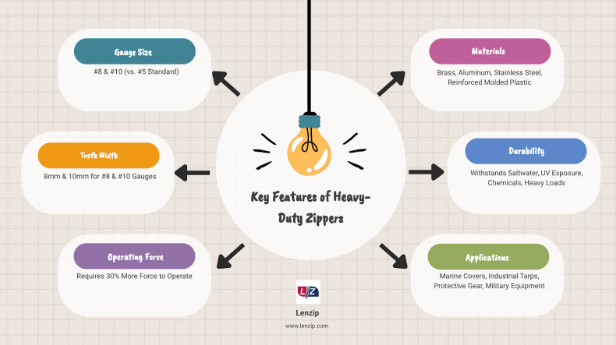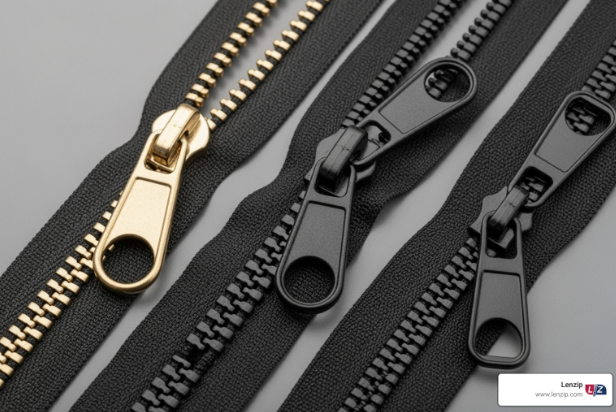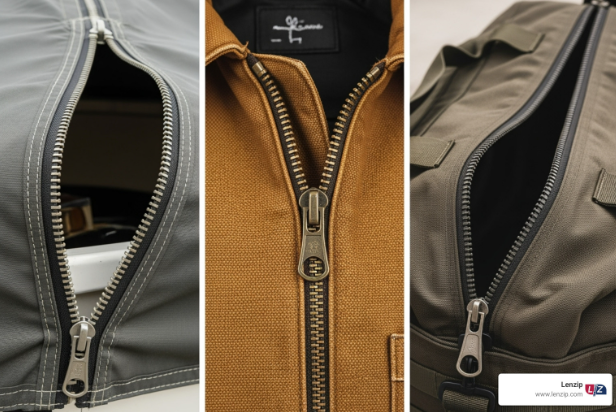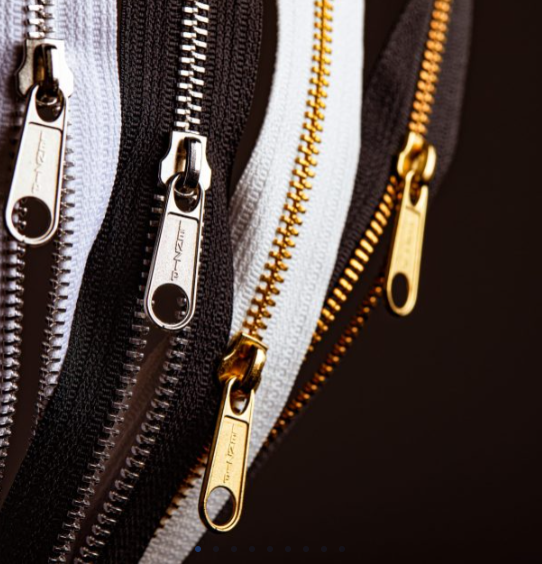Unzipping Strength:
The Ultimate Heavy-Duty Zipper Guide
Discover why heavy duty zippers are essential for demanding applications. Learn selection, materials, and care for ultimate strength.
The Ultimate Heavy-Duty Zipper Guide
Heavy duty zippers are specialized fasteners designed to handle extreme stress, frequent use, and harsh environmental conditions that would quickly destroy standard zippers. Unlike the #5 gauge zippers you’ll find on everyday clothing, heavy-duty options use #8 and #10 gauge construction with teeth measuring 8mm and 10mm wide respectively.
Key Features of Heavy-Duty Zippers:
- Gauge Size: #8 and #10 (vs. #5 standard)
- Operating Force: Require 30% more force to operate due to larger, stronger teeth
- Materials: Brass, aluminum, stainless steel, or reinforced molded plastic
- Applications: Marine covers, industrial tarps, protective gear, tents, military equipment
- Durability: Built to withstand saltwater, UV exposure, chemicals, and heavy loads
The difference isn’t just academic. As one industry expert notes: “The usage of zippers in today’s world has smoothened the work of tailors as they can be sewn directly on the garment than clamping the teeth on the cloth.” But when that garment is a firefighter’s suit or that application is a boat cover facing constant saltwater exposure, standard zippers simply won’t cut it.


Heavy-duty zippers solve critical problems for manufacturers and end-users alike. They prevent costly equipment failures, reduce replacement frequency, and ensure reliable performance in demanding applications where zipper failure could mean safety risks or significant downtime.
The investment in heavy-duty construction pays dividends through extended product life, reduced warranty claims, and improved customer satisfaction – making them essential components for any application where reliability matters more than initial cost savings.
When we talk about what makes a zipper “heavy-duty,” we’re essentially looking at its ability to withstand significant force, frequent manipulation, and environmental abuse without failing. It’s not just a fancy label; it’s a commitment to superior engineering and materials.
At the core of a heavy duty zipper is its size, specifically its gauge. While a common #5 gauge zipper might serve well on a light jacket, we move into the field of #8 and #10 gauge for truly demanding applications. These numbers aren’t arbitrary; they directly correlate to the width of the zipper’s teeth when closed. A #8 gauge zipper, for instance, boasts teeth that measure approximately 8mm across, while a #10 gauge is even more substantial at around 10mm. This increased tooth width directly translates to increased strength and durability.
Because of their larger teeth and more robust construction, heavy duty zippers generally require approximately 30 percent more force for operating compared to their standard counterparts. This isn’t a design flaw; it’s a testament to their strength. The stiffness and rigidity of their wider tape material, while limiting their use in highly flexible wearable items, contribute significantly to their ability to withstand immense side-pulling forces. This makes them exceptionally strong when pulled from the side, a critical factor in applications like industrial covers or heavy bags. For more detailed information on the fundamental components of any zipper, we invite you to explore our page on More info about zipper basics.
Beyond sheer size, several characteristics define a heavy duty zipper:
- Larger Teeth: As mentioned, the increased size of the teeth is fundamental. These aren’t just scaled-up versions of standard teeth; they are engineered for maximum interlock and resistance to separation.
- Stronger Tape Material: The fabric tape to which the teeth are affixed is also significantly more robust. Often made from durable polyester or nylon, it’s designed to resist tearing, abrasion, and degradation from UV exposure or moisture.
- Improved Slider Mechanism: The slider, the heart of the zipper, is beefed up for heavy-duty use. It’s typically made from stronger metals like brass or stainless steel, or high-performance molded plastic, and designed to endure countless cycles without bending or breaking.
- Robust Stops: Both the top and bottom stops are designed to prevent the slider from coming off the chain, even under extreme tension. These are often larger and more securely fastened than those on standard zippers.
Suitability for Thick Fabrics: The overall robust construction of heavy duty zippers makes them ideal companions for thick, heavy-duty fabrics like canvas, tarp, industrial textiles, or even leather. Their strength complements the material they’re sewn into, creating a cohesive, high-strength closure system. This is especially true when working with materials like Webbing.
Key Characteristics of Heavy-Duty Zippers
Beyond sheer size, several characteristics define a heavy duty zipper:
- Larger Teeth: As mentioned, the increased size of the teeth is fundamental. These aren’t just scaled-up versions of standard teeth; they are engineered for maximum interlock and resistance to separation.
- Stronger Tape Material: The fabric tape to which the teeth are affixed is also significantly more robust. Often made from durable polyester or nylon, it’s designed to resist tearing, abrasion, and degradation from UV exposure or moisture.
- Improved Slider Mechanism: The slider, the heart of the zipper, is beefed up for heavy-duty use. It’s typically made from stronger metals like brass or stainless steel, or high-performance molded plastic, and designed to endure countless cycles without bending or breaking.
- Robust Stops: Both the top and bottom stops are designed to prevent the slider from coming off the chain, even under extreme tension. These are often larger and more securely fastened than those on standard zippers.
- Suitability for Thick Fabrics: The overall robust construction of heavy duty zippers makes them ideal companions for thick, heavy-duty fabrics like canvas, tarp, industrial textiles, or even leather. Their strength complements the material they’re sewn into, creating a cohesive, high-strength closure system. This is especially true when working with materials like Webbing.

Anatomy of a Tough Zipper: Materials and Types
Think of a heavy duty zipper like a recipe – the ingredients matter just as much as the size. The materials we choose determine whether your zipper will laugh off saltwater spray, shrug off UV rays, or bend gracefully around corners without breaking a sweat.
Each material brings its own superpowers to the table. Corrosion resistance keeps metal zippers from turning into rusty relics in marine environments. Flexibility lets zippers bend and twist without throwing in the towel. And weight can make or break a product design – nobody wants a backpack zipper that weighs more than their lunch.
Essential Materials Used in Heavy-Duty Zippers
We’ve spent decades perfecting our material choices, and here’s what makes each one special:
Molded plastic zippers are the workhorses of outdoor applications. We inject plastic directly onto the zipper tape, creating teeth that practically laugh at the elements. These champions offer UV resistance that prevents them from becoming brittle under harsh sunlight – perfect for boat covers and outdoor gear that live in the sun. Their natural water resistance makes them ideal for marine applications where other materials might fail. When you see those tough boat covers still working after years of saltwater exposure, there’s probably a molded plastic zipper doing the heavy lifting.

Metal zippers bring serious strength to the party. Brass is our go-to for applications that need both muscle and good looks – it resists corrosion beautifully and can handle serious abuse. Aluminum gives you impressive strength without the weight penalty, making it perfect when every ounce matters. But when you need the absolute toughest option, stainless steel is your champion. It’s the material of choice for the most demanding industrial applications where failure simply isn’t an option.
Nylon coil zippers might surprise you with their heavy-duty capabilities. Made from continuous nylon filament formed into coils, they bring incredible flexibility to the table. These are the zippers that steer curves and corners like they were born for it. You’ll find them in sleeping bags that need to bend around your body and tents that fold into impossible shapes. They even have a neat trick – if a tooth gets misaligned, running the slider back and forth can often fix it right up.
Common Types and Their Applications
The way a heavy duty zipper opens and closes is just as important as what it’s made from. Separating zippers completely detach at the bottom, making them perfect for jackets and equipment covers that need to open fully. Two-way zippers feature dual sliders that can open from either end – brilliant for sleeping bags where you might want foot ventilation or long coats where you need sitting room.
Closed-end zippers stay connected at the bottom and work beautifully for bags and cushions where you just need access, not complete separation. When water is the enemy, water-resistant zippers step up with special coatings that create tight seals – their vinyl treatments can even eliminate the need for storm flaps. And for the ultimate safety applications, fire-retardant zippers resist high temperatures and burning, keeping firefighters and industrial workers protected.
Each type serves a specific purpose, and choosing the right one can make the difference between a product that performs and one that excels. To explore more about how these technologies come together, Learn more about zipper technology.

How to Select the Right Heavy-Duty Zipper for Your Project
Selecting the perfect heavy duty zipper for your project isn’t just about grabbing the strongest one off the shelf. It’s like choosing the right tool for a specific job – you need to match the zipper’s capabilities to your unique requirements. After 80 years in this business, we’ve learned that the best zipper is the one that’s perfectly suited to its environment and application.
How to Select the Right Heavy-Duty Zipper for Your Project
Selecting the perfect heavy duty zipper for your project isn’t just about grabbing the strongest one off the shelf. It’s like choosing the right tool for a specific job – you need to match the zipper’s capabilities to your unique requirements. After 80 years in this business, we’ve learned that the best zipper is the one that’s perfectly suited to its environment and application.
When we work with clients, we always start with the fundamentals: what are your project requirements? Understanding how your product will be used is crucial. Will it face constant opening and closing, or occasional access? What kind of pulling forces will it encounter? These aren’t just technical questions – they’re the foundation of finding your ideal zipper solution.
Environmental factors play a huge role in zipper selection. A zipper that performs beautifully in a climate-controlled warehouse might fail miserably on a boat deck. We also examine load frequency – how often that zipper will be cycled through its paces. Finally, there’s fabric compatibility. Even the strongest heavy duty zipper won’t perform well if it’s paired with fabric that can’t handle the stress.
Choosing the Correct End-Type and Length
Beyond materials and gauge, the zipper’s end-type and length are make-or-break factors for functionality. Get these wrong, and even the perfect material choice won’t save your project.
The separating versus closed-end decision comes down to one simple question: do the two sides need to come completely apart? Separating zippers (also called open-end) are your go-to for jackets, equipment covers, and anything that needs to open fully. Closed-end zippers work perfectly for bags, cushions, and applications where the opening stays connected at one end.
Two-way functionality is a game-changer for larger items or when you need access flexibility. These zippers can open from either end, making them invaluable for sleeping bags (bottom ventilation, anyone?) and large industrial enclosures. They’re also fantastic for long coats where you might want bottom access while keeping the top closed.
Getting the length measurement right is critical, and there’s a specific technique: measure your completely closed zipper from the very top of the teeth to the very bottom of the teeth. Don’t include any fabric extensions or head tape in your measurement – just the actual functional zipper length.
For commercial and industrial applications, standard lengths rarely cut it. That’s where our custom length capabilities shine. We regularly create extra-long zippers extending hundreds of inches for large tarps, specialized tents, and industrial equipment. No project is too big or too unique – that’s the advantage of working with a manufacturer that’s been solving zipper challenges for eight decades.

Best Practices for Zipper Care and Maintenance
Think of your heavy duty zippers like a high-performance engine – they’re built to last, but a little TLC goes a long way toward keeping them running smoothly. Even the toughest zippers appreciate some attention, and the good news is that proper maintenance is surprisingly simple.
The biggest enemy of any zipper isn’t heavy use – it’s the small stuff that sneaks in. Dirt, sand, salt, and other debris love to hide between zipper teeth, turning what should be smooth operation into a frustrating wrestling match. Regular cleaning is your first line of defense, especially if your zippers face harsh outdoor or industrial environments.
For routine cleaning, a damp cloth or soft brush works wonders. Gently work along the teeth to remove any accumulated grime. If you’re dealing with marine applications, this step becomes even more critical. Salt water is particularly sneaky – it seems harmless when wet, but as it dries, it leaves behind corrosive crystals that can seriously damage metal components. A simple rinse with fresh water after saltwater exposure prevents this buildup and keeps your zippers functioning like new.
Before you reach for any lubricant, make sure those teeth are completely debris-free. Here’s where specialized tools really shine. A unique push-pull brush top can effectively deliver cleaner between the teeth while physically removing those stubborn deposits that cause jams. It’s like giving your zipper a proper deep clean before the spa treatment.
Silicone-based lubricants are your zipper’s best friend. Products like Zip Tech or Max Wax Stick create a protective barrier that keeps everything moving smoothly without attracting dust and dirt. This is crucial – you want protection, not a magnet for more problems. Oil-based lubricants might seem like a good idea, but they’re actually troublemakers in disguise, attracting debris that leads to more jams and wear.
Quality lubricants do more than just smooth operation. They protect against rust, corrosion, chlorine, and salt in all temperatures, ensuring your zippers keep flowing freely regardless of what Mother Nature throws at them.
Make it a habit to give your heavy duty zippers a quick inspection now and then. Look for bent or missing teeth, frayed tape, or a slider that’s become too stiff or too loose. Catching these issues early can save you from a complete zipper failure down the road – and trust me, zippers always seem to fail at the most inconvenient times.
While you can’t replace individual teeth on heavy duty zippers (if a tooth breaks, the whole zipper needs replacing), you can often swap out damaged sliders and stops. It’s like changing a tire instead of buying a new car – addressing these smaller issues promptly can save the entire zipper and extend its working life significantly.
For all your zipper maintenance needs, including high-quality lubricants and specialized tools, you can Find zipper lubricants and tools. A little preventive care today means reliable performance for years to come.
Frequently Asked Questions about Heavy-Duty Zippers
After working with heavy duty zippers for 80 years, we’ve heard just about every question you can imagine. Let me share the answers to the ones that come up most often – they might just save you time and money down the road.
Can a heavy-duty zipper be repaired?
Here’s the good news: many zipper problems can be fixed without replacing the whole thing. But it really depends on what’s actually broken.
Slider replacement is usually straightforward. When your slider gets worn out, bent, or starts jamming, we can often swap it out for a new one. This is probably the most common repair we see, and it’s much cheaper than starting over with a new zipper.
Stop replacement is another repair that works well. Those little metal or plastic pieces at the top and bottom that keep your slider from flying off? If they break or fall off, we can usually install new ones without much trouble.
But here’s where things get tricky: tooth damage. Unlike lighter zippers where you might be able to work around a broken tooth, heavy duty zippers are built differently. When a tooth breaks or gets severely damaged, you can’t just replace that one piece. The teeth are so integrated into the chain that individual repair isn’t possible.
Full replacement necessity becomes the reality when teeth are damaged or when the tape itself tears significantly. I know it sounds drastic, but trust me – trying to nurse along a zipper with broken teeth is like putting a band-aid on a broken bone. You’ll end up replacing it anyway, usually at the worst possible moment.
What are the most common applications for heavy-duty zippers?
Heavy duty zippers show up everywhere that regular zippers would wave the white flag. We see them working hard in some pretty demanding places.
Marine upholstery is huge for us. Boat covers, bimini tops, and marine enclosures face salt spray, UV rays, and constant moisture – conditions that would destroy a regular zipper in no time. Our marine-grade zippers keep boats protected season after season.
Industrial tarps need closures that won’t quit. Whether it’s truck covers hauling cross-country or construction tarps protecting equipment, these applications demand zippers that can handle serious stress and weather.
How much does it cost to replace a luggage zipper?
The cost of luggage zipper replacement depends on your approach.
DIY repairs are very budget-friendly. Repair kits are typically under $20, and individual parts like no-sew sliders can cost just a few dollars.
Professional repairs cost more, typically running between $75 to $125. The final price depends on the zipper’s complexity, the luggage type, and local labor rates.
While $75 may seem steep, it’s almost always less than buying new luggage. For a $200 suitcase, a repair extends its life for many more trips, making it a smart financial and environmental choice.
Your Partner in Production
We understand that every project is unique, which is why we offer the flexibility you need. Our B2B focus means we can support your business with options that work for you, including minimums as low as 25 units. We are not just a supplier; we are your partner, committed to helping you find the right solution to fit your specific requirements.
Let’s Find the Right Solution for You
Ready to upgrade to the Lenzip standard? We’re here to help.
Talk to a representative today. We’ll help you find the right solution for your project
Call us at (847) 368-9000 or request a quote today.
